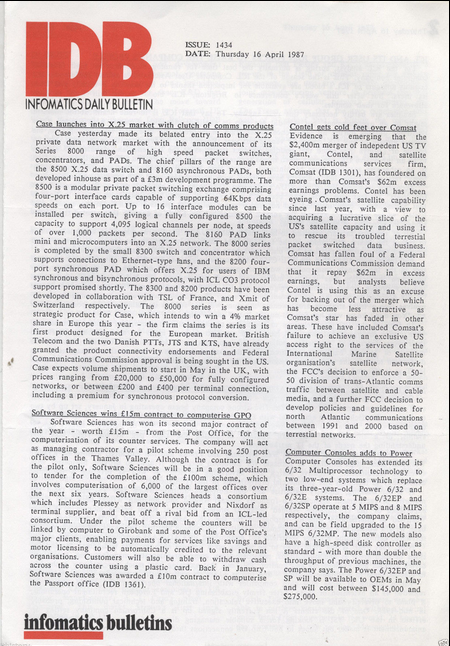Referred to by Bill Gates as “that little yellow sheet”, Computergram was a daily IT newsletter published from 1984 by APT Data Services, founded by Peter White (publisher) and Tim Palmer (editor). Tim sadly died in 1997 at the age of 54. This site aims to preserve some memory of the publication, which in its heyday was essential reading for the IT industry before the Internet news sites took hold. Computergram’s parent company APT (later Computerwire) later launched many other IT publications, including Unigram.x, Computer Business Review, Software Futures and Unix News.
Computergram was manually printed by the journalists in the Sutton Row news and sales office (and later off-site in a succession of dingy satellite offices in nearby Flitcroft Street, Hanway Place and Newman Passage), folded, enveloped and addressed. And then a courier, or sometimes one of us, had to get the bundle to Mount Pleasant Sorting Office by around 7pm. But electronic versions had been available from the early days on services such as Telecom Gold and Newsnet. Sending out a print daily in the US wasn’t practical, so the focus there quickly became online. By 1997 the company name and website had changed to Computerwire and the print copies were eventually stopped in April 1998.
Computerwire was finally sold off to its primary investor and advisor, Interregnum, for just £44,000 (€68,900) in June 2002, and subsequently passed on to Datamonitor, which agreed to absorb the £1.02m in debt.
In the now demolished Computergram offices at 12 Sutton Row, just off Soho Square in London and right opposite the Astoria Theatre (also demolished), there were a row of filing cabinets where all the spare back issues were neatly filed. Indexes were compiled regularly by the most junior journalists. I don’t know where those archive copies ended up. Some of the text is available online, and there are some holdings in various libraries in the UK and the US. The “history” boxes that used to appear on the bottom on the back page of each issue provide some record of what was in each issue, and its those I’m using here. The ones I can get currently get hold of cover a five year span from issue 1 (August 13 1984) up until issue 1,239 (August 11, 1989).
Update: We’ve just heard that Peter White, who went on to found Rethink Research, passed away in September 2023. Obituary is here. https://rethinkresearch.biz/articles/peter-white-founder-visionary-maverick-dies-suddenly/
A complete issue (No 1,970, February 28, 1992) can be found here.
Currently missing: Nos 55 (Oct 29, 1984); 77 (Nov 28, 1984); 93 (Dec 20, 1984); 95 (Jan 3 1985); 559 (Nov 10, 1986); 561 (Nov 12, 1986); 562 (Nov 13, 1986); 564-5 (Nov 17-18, 1986).
 The Computergram offices were at 4th Floor, 12 Sutton Row, off Soho Square in London. Entrance on the immediate left. Opposite was the Astoria Theatre. Both buildings now demolished to make way for Crossrail.
The Computergram offices were at 4th Floor, 12 Sutton Row, off Soho Square in London. Entrance on the immediate left. Opposite was the Astoria Theatre. Both buildings now demolished to make way for Crossrail.
TIM PALMER – COMPUTERGRAM INTERNATIONAL EDITOR 1984 – 1997
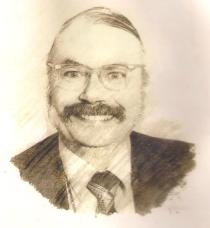 Tim Palmer edited Computergram International from its launch issue in 1984 until he died on Tuesday June 3, 1997. This tribute piece, by APT founder and publisher Peter White, appeared in Computergram on Thursday June 5, 1997.
Tim Palmer edited Computergram International from its launch issue in 1984 until he died on Tuesday June 3, 1997. This tribute piece, by APT founder and publisher Peter White, appeared in Computergram on Thursday June 5, 1997.
Tim Palmer, one of the UK’s foremost IT watchers and editor and founder of this product Computergram International, and my partner in the business ComputerWire, died Tuesday night unexpectedly after a short illness, aged 54. Tim was a remarkable man, one of the greats of both the publishing business and the computer industry. He had a razor sharp intellect, ready wit and an unrivaled grasp of the fast-moving world of computers. He disguised this with a wizened and ancient appearance and a stubborn streak that any mule would have been proud of. To any journalist who worked around him he was an icon of knowledge; we used to call him our search engine because he could tell you things about the industry that our own internal decade-old database just didn’t have, and he had a faster response time.
See the future
What always impressed me the most was his ability to see the future. He’d glance at some balance-sheet, or some set of company results and point out that one big company should buy another big company or the opposite, that this merger or that merger would be a disaster and he always ended up being right. I know that many clients bought Computergram just for this insight, and some unlikely turns of events were either predicted by him, or started by him when someone took up one of Tim’s ideas from Computergram. To my knowledge he never made a spelling mistake, never missed a deadline in his life and had some influence over the direction and careers of at least 100 writers. He loved his job above almost everything else. He worked 14 hours a day most days and had to be locked out of the building in order to get him to take a holiday. He was working here as recently as three weeks ago. During the 13 years he worked on Computergram he made daily deadlines look easy and always took the pressure off his staff, absorbing it into himself. He leaves his beloved mother and sister behind whom he admired and who were both often in his thoughts and conversations. Tim came to journalism via a brief career at Plessey designing communications equipment, followed by a trip around the world on a double-decker London bus with a troupe of friends. This took three years, and was funded by promotional songs they adapted from Old English folks songs which they sang to locals as they handed out flyers from sponsors. It was this trip that gave him his fondness for India, where we always thought he’d retire, and his understanding of Japanese business and many lifelong friends. His old friends told me that he was essential in their singing troupe, not for his voice, but because he was the only one who could remember all the lyrics. It was after this trip, over twenty years ago, that he moved into computer journalism. Tim suffered all his life, from the age of 16, with disadvantages that would have marred lesser men. He was swept off a scooter at the age of 16 under a bus (ironic that he would choose to later travel the world on one). The resulting damage to his legs and left arm was never quite repaired but it never for one moment halted his vitality or personal growth. Perhaps it made him shy, perhaps a little less confident than he otherwise might have been, but once people got through the first hesitant contact he quickly became an entertaining workmate, generous to a fault, and a supportive and thoughtful man. Tim was a distinguishing feature at Computer Weekly, the oldest and best established computer trade paper in the UK, where he effectively became chief reporter. Once Reed Group decided to move this paper out of London, Tim stubbornly stayed, moving to arch rival VNU and its then weekly title Infomatics.
Little yellow sheet
Infomatics was launched to fend off a US competitor and once successful it was switched to monthly and was about to lose three writers when Tim came up with the visionary idea in 1980 to launch a daily for the computer industry, using these spare writers and dubbed the Infomatics Daily Bulletin. He launched what Bill Gates was heard to refer to as that little yellow sheet, Computergram, with a handful of colleagues in 1984. He has been the spirit behind the industry’s most successful and idiosyncratic daily paper and until earlier this year, when he began training up a new, enlarged editorial team, he personally oversaw the output of around 7,500 words of the most eloquently worded wisdom about the world’s most sophisticated industry that you are ever likely to read. He was intrigued by the business and entertained by its characters. Their follies and inanities had to be recorded too so he made sure no issue of Computergram International was ever delivered without a ‘funny’ on the back page. The last conversation I had with him wasn’t about his illness, it was about whether Netscape should buy Novell. But the people who knew him here, his closer friends out in the industry at large and past colleagues alike, will know that despite his obsession with the industry, Tim still managed to treat us to intensely opinionated but delightful thoughts on world cricket, and jazz. He even managed to find time to write his own musicals. Tim was a one-off. They didn’t so much throw away the mould when they made him as craft him by hand. He counted for something. We shall all miss him.
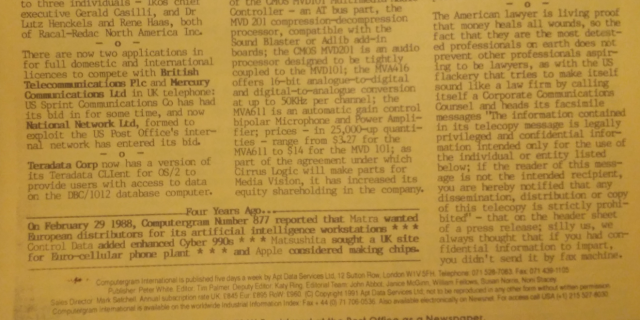
A history box in context (from CI No 1,870, Friday, February 28 1992), showing an example of the daily “funny”.
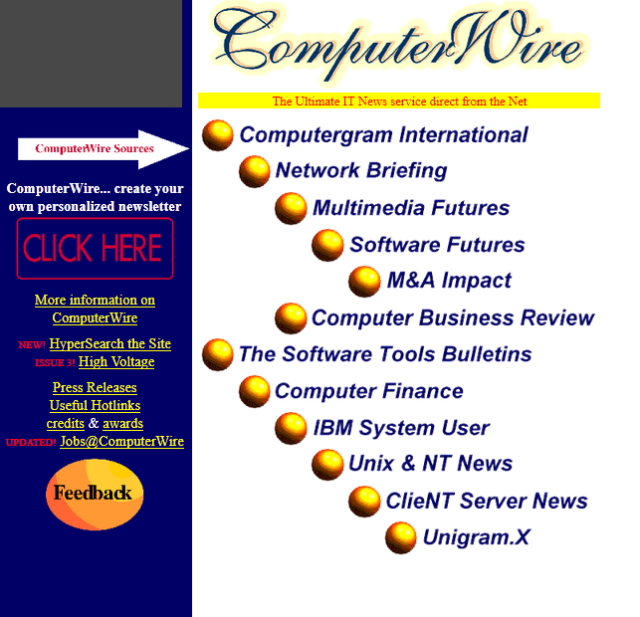
Computerwire website, as it was in 1997

Logo of Unigram.x, the weekly Unix newspaper, which came out on a Friday. Material from Unigram was used in Computergram and vice versa.

Editorial team, as it was in 1992
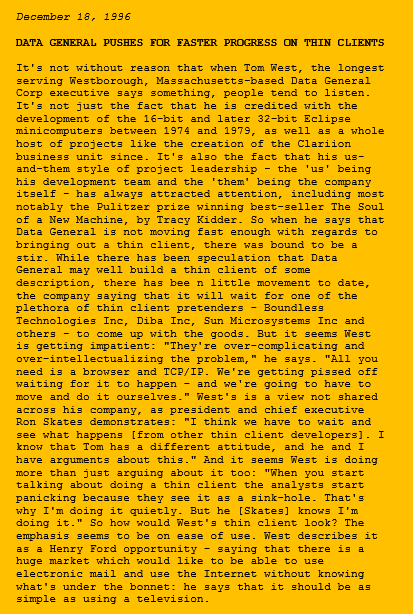
Letter to The Guardian, August 17, 1989
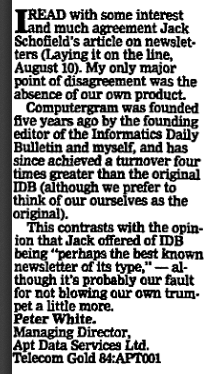
Job advert, The Guardian, December 18 1989
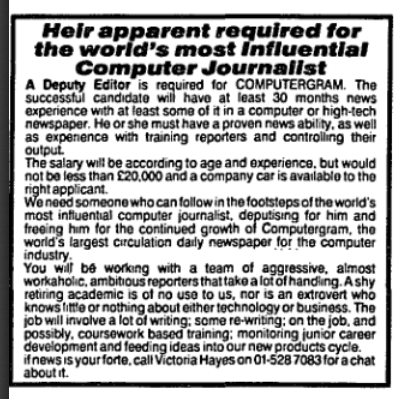
Job advert, 22 July 1985, The Guardian
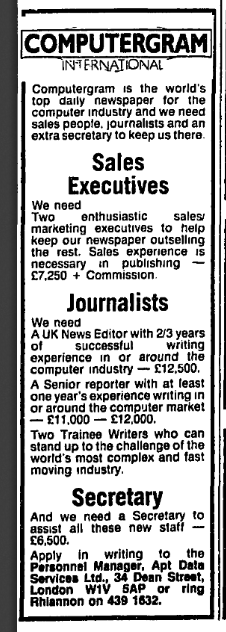
Credits (online edition), June 1999
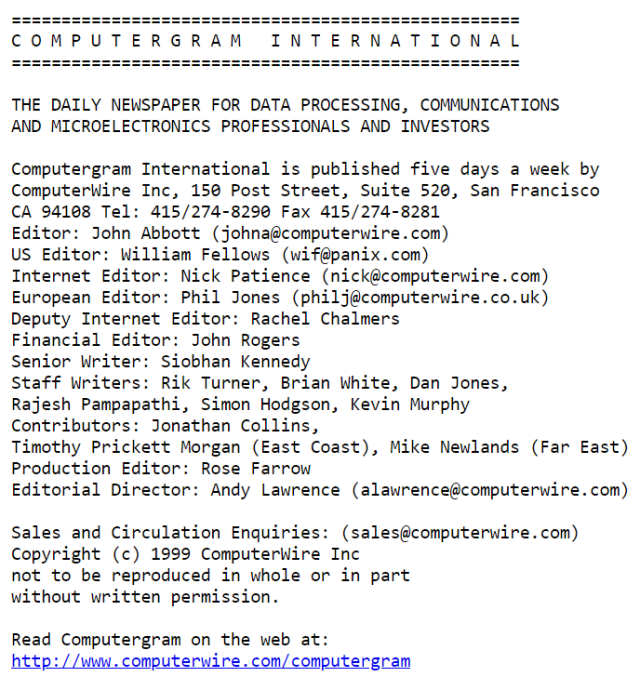
Infomatics Daily Bulletin – forerunner and (for a while) rival to Computergram. It was published by VNU, but the idea to launch it came from Tim Palmer, without much support from VNU management. There are some details in this post on IDB – see especially the comments at the end by Alan Burkitt-Gray, editor of Infomatics Magazine in 1983 while Tim was editor of IDB: http://buziaulane.blogspot.co.uk/2014/12/bpn-1697-1984-first-daily-online.html. This example of the paper issue is from 16 April 1987.
